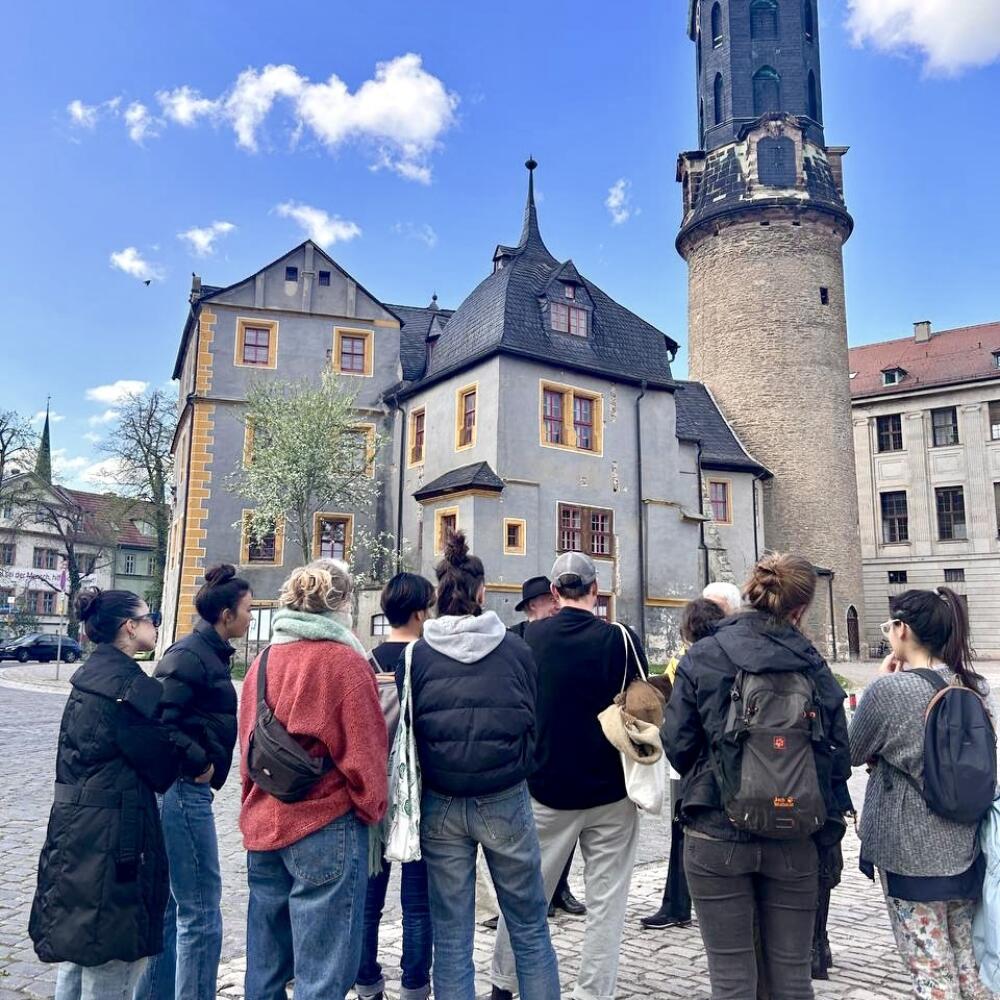Students visit Weimar and the Buchenwald Memorial
From 10-12 April 2024, students visited Weimar and the Buchenwald Memorial as part of their studies at the Goetheanum
From 10-12 April, 17 students from the Anthroposophical Studies on Campus visited Weimar and the Buchenwald Memorial as part of their studies at the Goetheanum. A trip that brought the group into direct contact with the lights and shadows of history through interaction with the cultural heritage of the city. As a group, the students retraced the steps of individualities like Schiller, Goethe and Steiner, as well as Art Nouveau and Bauhaus artists. They also witnessed the remnants of the devastation of National Socialism in the city and its surroundings.
Preparations for the trip began in Dornach with introductions to the history of Weimar and its significance in Rudolf Steiner's biography. Arriving in Weimar, the journey began in front of the walls surrounding the garden of Goethe's Haus on Frauenplan, under the windows of Steiner's first residence in Weimar as a visitor. He would later move to the city to carry out his work as editor of Goethe's scientific works, which he completed, as well as his book on Nietzsche and the Philosophy of Freedom - a book on which the students had worked intensively every day of the winter term.
Under the guidance of Peter Selg and Constanza Kaliks, the group was able to approach the artistic and philosophical works of Goethe and Schiller, Nietzsche, van de Velde and Walter Gropius. They began with Schiller's Letters on the Aesthetic Education of Man and a mention of Goethe's Fairy Tale. By looking at Schiller's ideas on the interplay between the sense, form and play drives, the group were able to consider the role of artistic endeavour in the cultivation of the soul and how this can ultimately lead to freer societies. This set the tone for the visit to Goethe's houses (Gartenhaus and Frauenplan), which seemed to us to be testimonies to their efforts to cultivate inner and outer spaces of inspiration, reflection and creativity in the service of human development. These interactive visits invited the students to reflect on who they may have been as people, their motivations behind their work and striving for cultural renewal.
In the evening the group gathered at the Villa Henneberg Waldorf Kindergarten, a beautifully renovated Van de Velde building that was purchased by a group of young teachers shortly after the fall of the Berlin Wall. Dieter Rocktäschel kindly took us through the events leading up to the founding of the kindergarten during the reunification of Germany as a joint effort by anthroposophists from West and East Germany. His direct testimony broadened the students' understanding of the complex history of the place.
On the afternoon of the second day, the students' gaze turned to the fatal events of the 20th century, which were the result of the Nazi era in Germany. Starting at the Gauforum, Peter Selg introduced Hitler's interest in Weimar as a cultural centre and the rise of Nazism in the area. The group then travelled by bus to the outskirts of the former Buchenwald concentration camp, where over 270,000 people were imprisoned and over 55,000 died as a result of the Nazi regime between 1937 and 1944. Together we walked the Gedenkweg with a quiet earnestness. Later in the evening we realised that we had arrived at the gates of the camp on the afternoon of 11 April, exactly 79 years after its liberation.
We made our way respectfully through the remains of the barracks, taking time to pay tribute to the many memorial stones erected in memory of so many lives. We visited the superbly curated and moving exhibition "Means of Survival - Testimony - Work of Art - Pictorial Memory". Here the group witnessed the artistic expressions of the prisoners, including secret paintings, sketches, sculptures and drawings - some from their time in Buchenwald, others in memory of their lives before imprisonment, and some created in the aftermath as survivors. Art as resistance in the face of dehumanization and evil.
As we left, the students carefully placed their own artistic creations on the ground near the "small camp": light catchers made of beeswax, prepared in their sculpture class at the Goetheanum. In the evening there was another round of sharing in the kindergarten, which led to important reflections on questions of good and evil, responsibility and human dignity.
What is the meaning of such a journey for students of Anthroposophy? Only the students themselves can answer this question, and it will probably be some time before they are able to articulate the impact of the experience. But in a final round the group expressed immense gratitude for the opportunity to approach these contrasts and complex questions and to carry them in their next steps at the Goetheanum and beyond. The trip will take place again next year as part of the Anthroposophical Studies on Campus 2024/5 study program.
Applications for Anthroposophy Studies on Campus are now open. The program is open to anyone interested in the work of Rudolf Steiner and anthroposophy in general. The program is held in English and partly in German (the latter subject to a minimum number of participants).

